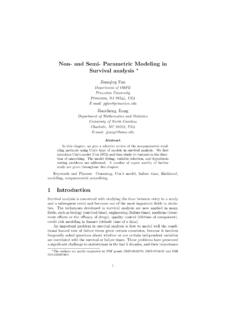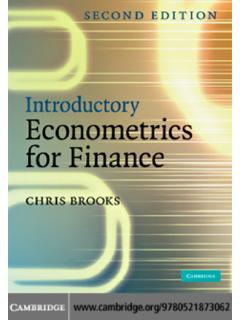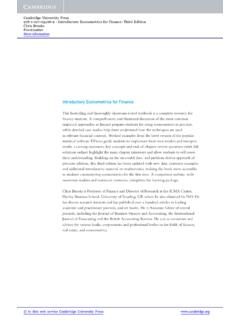Transcription of An introduction to financial econometrics
1 An introduction to financial econometricsJianqing FanDepartment of Operation Research and Financial EngineeringPrinceton UniversityPrinceton, NJ 08544 November 14, 2004 What is the financial econometrics ?This simple question does not have a simple answer. The boundary of such an interdisciplinaryarea is always moot and any attempt to give a formal definition is unlikely to be successful. Broadlyspeaking, financial econometrics is to study quantitative problems arising from finance. It uses sta-tistical techniques and economic theory to address a variety of problems from finance. These includebuilding financial models, estimation and inferences of financial models, volatility estimation, riskmanagement, testing financial economics theory, capital asset pricing, derivative pricing, portfolioallocation, risk-adjusted returns, simulating financial systems, hedging strategies, among invention and trade globalization have brought us into a new era of financialmarkets.
2 Over the last three decades, enormous number of new financial products have been createdto meet customers demands. For example, to reduce the impact of the fluctuations of currencyexchange rates on a firm s finance, which makes its profit more predictable and competitive, amultinational corporation may decide to buy the options on the future of foreign exchanges; toreduce the risk of price fluctuations of a commodity ( lumbers, corns, soybeans), a farmer mayenter into the future contracts of the commodity; to reduce the risk of weather exposures, amuseparks (too hot or too cold reduces the number of visitors) and energy companies may decide topurchase the financial derivatives based on the temperature.
3 An important milestone is that in theyear 1973, the world s first options exchange opened in Chicago. At the very same year, Black andScholes (1973) published their famous paper on option pricing and Merton (1973a) launched generalequilibrium model for security pricing, two landmarks for modern asset pricing. Since then, thederivative markets have experienced extraordinary growth. Professionals in finance now routinelyuse sophisticated statistical techniques and modern computation power in portfolio management,securities regulation, proprietary trading, financial consulting and risk econometrics is an active field of integration of finance, economics, probability, statis-tics, and applied mathematics.
4 Financial activities generate many new problems, economics pro-vides useful theoretical foundation and guidance, and quantitative methods such as statistics, prob-1ability and applied mathematics are essential tools to solve quantitative problems in finance. Toname a few, complex financial products pose new challenges on their valuations and risk man-agement. Sophisticated stochastic models have been introduced to capture the salient features ofunderlying economic variables and used for security pricing. Statistical tools are employed to iden-tify parameters of stochastic models, to simulate complex financial systems and to test economictheories via empirical financial are several books on financial econometrics and related areas.
5 Campbellet al.(1997) isan excellent book on a comprehensive overview of financial econometrics . A distinguished featureof the book is that it includes many empirical studies. Gouri eroux and Jasiak (2001) give a conciseaccount on financial econometrics , but some prerequisites are needed. Tsay (2002) is an excellentbook on the analysis of time series. It emphasizes on the methodological power of time seriestechniques on the analysis of financial data. A very nice introductory book on finance econometricsis Ruppert (2004), which aims at undergraduate or master taught a financial econometrics class for the master students in finance at Princeton semester, I used the aforementioned books and the book by Fan and Yao (2003) as referencebooks in an attempt to gather the strengths from these books and to give students a comprehensiveoverview of the field.
6 While the curriculum is expected to be revised from time to time, I listed thetopics covered in my class to give readers an Overview of statistical methods2. Predictability of asset returns3. Discrete time volatility models4. Efficient portifolio and CAPM5. Multifactor pricing models6. Intertemporal equilibrium and stochastic discount models7. Expectation and present value relation8. Simulation methods for financial derivatives9. econometrics of financial Forecast and management of market risks11. Multivariate time series in finance 12. Nonparametric methods in financial econometrics The field of financial econometrics is much wider than what I presented here.
7 However, theabove topics give students a sample of taste on the am fully aware the challenge to give an overview of a fast growing field in such a limited can easily imagine the undue task if you were asked to write an overview of of covering every aspect of financial econometrics , I just briefly touch a few importanttopics where statistics plays an important of financial derivativesFinancial derivatives are mainly introduced to reduce various exposures of market risks. Theyare also used in speculative trading to increase leverages. They include options on stocks, stockindices, bonds and bond indices, futures on commodities and currencies, and options on the futuresand so on.
8 An option gives the right to its holders to buy or sell certain asset at certain price,called strike price, at or before the expiration. An European option is the one that can only beexercised at the expiration date, while an American option can be exercised any time before itsexpiration. Options on the stock indices such as the standard and poor 500 index are usuallyEuropean, while options on individual stocks are usually American. See Duffie (2001) and Hull(2003) for a comprehensive account on this are usually used to hedge against certain financial risks, weather conditions, and naturaldisasters such as catastrophe events.
9 Consider, for example, a company which expects to receive250 million euros in 3 months from its sales in Europe. The financial officers of the company do notwish to have unpredictable earnings due to the fluctuations of the exchange rates between the USdollars and euros, making the quarterly earning less predicable. One way to reduce the exchangerate risk is to buy the options, or more frequently the futures, on the currency exchange maturedin 3 months with different strike prices. Indeed, the company does not have to buy the actualfutures on the US dollars, but to buy the options on the futures of the US dollars.
10 The idea is thatif the value of the euro drops, the options on the future will rise to offset the lost in the currencyexchanges. As one can see, combinations of different financial instruments can yield various aim is to reduce the market risks to a manageable level. In this sense, financial derivativesserve a similar purpose to that in insurance industry. One advantage of the financial derivatives isthat it is very liquid, trading at a large volume every trading the options give right for holders to buy or sell financial assets, they are valuable. Thequestion is how to value them. The celebrated formula of the Black and Scholes (1973) was derivedbased on what so called relative pricing.











